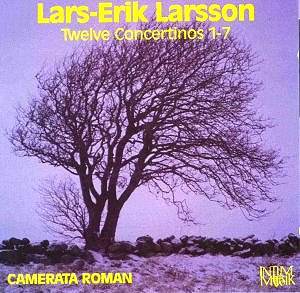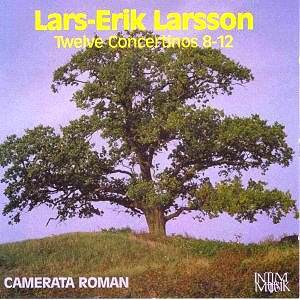Larsson is here at his lightest but for this
Swedish composer nothing trite or kitsch is allowed in. The Concertinos
aim to entertain. Rather like Mozart's cassations, serenades or
suites they have no grand pretensions, no pomp, no obese tendencies
and little that you could call epic. The music-making here is
nevertheless irresistibly melancholy, philosophical, delightful
and buoyant.
The flute concertino is flighty and romantic
with a melancholy central movement. The vigorous music sounds
faintly like Holst as in the string writing in Brook Green
and St Paul's. The oboe work has a notably jaunty
finale which sounds a little like a cross between Moeran's Serenade
and the string writing of Arnold Rosner. Urban Claesson's clarinet
is given slightly caustic melodic material like Rawsthorne
perhaps though things are sweetened in the finale rather like
Arnold Cooke. The ten minute bassoon concertino saunters
along in winning form with a nostalgic andante. At 13.03 the horn
concertino is almost as long as the viola work. The morose
central movement takes us into Hindemith territory but such negative
feelings are banished by a positive, almost aggressively stepping
out and wonderfully buoyant finale. The trumpet concertino
(only 6.14) romps along like a modern counterpart to the famous
Haydn or Hummel concertos. The last movement is perhaps rather
pedestrian after two much more inventive movements. The trombone
leers, muses and serenades like a louche Lothario becoming
morose in the central movement and regaining his appalling self-confidence
in the finale.
The five string concertinos are on the second
volume. The violin work has a more ecstatic feel than the
others. It broadly inhabits a land between Tippett's Concerto
for Double String Orchestra and Vaughan Williams Lark Ascending.
True to one of its characters the viola concertino is ominously
rhapsodic and seems even darker given the husky timbre of Bjørg
Værnes and this darkens further for the adagio and is hardly
dispelled by the Shostakovich-influenced finale. The barely ten
minute cello concertino is very similar is effect. The
adagio of the double bass work has a rocking string orchestral
accompaniment that evokes Nystroem's Sinfonia Del Mare as
does the same movement in the flute work. It is actually a very
attractive movement rather in contrast to the academic finale.
The piano concertino glitters, swaggers and scorches along
with recollections of Shostakovich in the outer movements while
the middle movement is more crystalline and pristine in quality
- touching - even sentimental. String writing that can evoke Vaughan
Williams' Concerto Grosso contrasts with motoric though
not heartless patterning from the piano. Then when the final strait
is in site the athleticism evaporates for a reflective conversation
between string solo voices and the decorative piano before such
tender musings are chased away.
Only the flute concertino is with full orchestra.
The other eleven use a body of strings. All of the concertinos
are grouped under Opus 45. The Flute Concertino is Op. 45 No.
1. The Piano Concertino is Op. 45 No. 12. The others are numbered
sequentially as above. All are in three movements. The longest
is 16.59 (piano) and the shortest (trumpet) 6.19. These are terse
little pieces with strong internal contrast across the time span
of a concert overture.
The two discs are available separately so you
can pick and choose, experiment and only buy the other if the
one you have tried appeals to you. Volume 1 covers Op. 45 Nos.
1-7 - all the works for woodwind while Vol. 2 has the remaining
works for various forms of string instrument. All very systematic
and rounded.
The notes are really scanty (about 300 words)
although they give you the essentials of the cycle and about the
conductor-less orchestra. They are identical for the two discs.
There is a good photographic study of Larsson and plates for each
soloist.
I have not heard the BIS (BIS-CD-473/474) but
I expect it to be good. That said I cannot fault this production
which is a fully enjoyable and will not disappoint you if you
have a taste for concise little concertos that demand and reward
you attention. They do not sound like Malcolm Arnold but their
layout and intentions are surely similar. Beautifully recorded.
Thoroughly recommendable.
Rob Barnett

